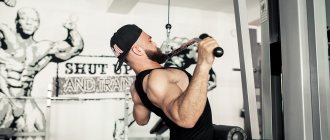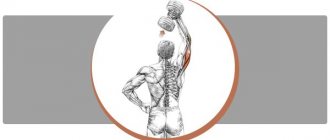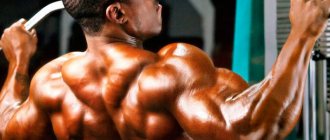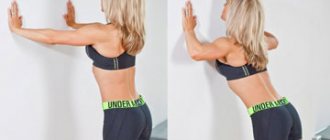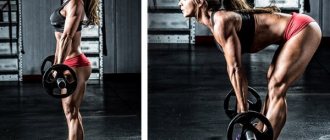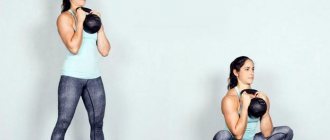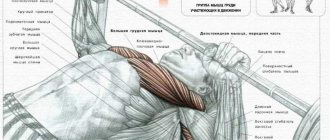Reverse grip triceps extensions work both the lateral head of the triceps and the muscles of the forearms. This exercise works the muscle well in isolation and helps strengthen your grip. But it cannot serve as a replacement for basic movements. When should you choose reverse grip extensions and in what case are they more promising than the regular extension option?
Content
- 1 Options for performing exercise 1.1 Extension of the arms from behind the head in the lower block
- 1.2 Alternately extending the arms upward in the lower block
Lower block arm extension
Lower block arm extension
Lower block arm extension is a formative exercise aimed at training the triceps based on the principle of isolating muscle groups. An isolated exercise involves extension of only one elbow joint (specialized work of only one muscle occurs - the triceps).
The exercise works the elbow muscles and all three heads/bundles of the triceps. When performed with a standard overhand grip, the outer head of the muscle works predominantly. If you hold the roller with an underhand grip, with your palms turned, the load on the inner head of the triceps is greater.
The exercise can be done on a vertical block (for back training) or in a block frame, which helps distribute the load on the triceps more conveniently.
The advantage of the exercise is minimal stress on the spine.
What to combine with?
Since standing arm extension on a block is an isolating exercise, it must be correctly combined with the base. First of all, when working with isolation, you should forget about supersets (at least for beginner athletes).
To warm up the muscles well, before entering the block machine, it is recommended to do 3-4 sets of bench presses (without bending!) with a narrow grip. Additionally, you can add a French press approach. To completely turn off the pecs and deltoids, in order to eliminate the possibility of cheating on the approach, you should use a heavy military press, or its seated variation on a Smith bench. Only by turning off the auxiliary muscles from this exercise can you achieve maximum development and isolation of the triceps extensor.
If for some reason the triceps are not worked on chest day, then a recommended warm-up set would be a bent over arm extension with a light weight, or work on lifting dumbbells to the sides (to eliminate the deltoids from the work). In this case, the pectoral muscles can take most of the load.
Note: With ideal technique, which is trained exclusively by working with light weights, you don’t have to worry about the work of other muscles, since the load will fall exclusively on the triceps. But don’t forget about warming up, which can be done with light weights or any other triceps set, including combination with flexor supersets.
Exercise options
Performed on a simulator with a lower block while standing. If you feel discomfort in this position, use an incline bench or try doing the exercise while kneeling with your back to the block.
Extension of arms from behind the head in the lower block
Technique for performing the exercise.
- Attach the handle to the upper block of the machine. Having established the desired weight, take the starting position.
Starting position: Grasp the handle with your palms facing up. Stand straight with your back to the machine, your body is slightly tilted forward (slight arch in the lower back), your feet are shoulder-width apart, or one leg is moved slightly forward.
- Bend your arms behind your head. Turn your elbows out to the sides.
- Slowly, as you exhale, extend your arms until they are completely straight. The shoulders and upper arms should remain motionless throughout the entire exercise.
- Take a short pause and also slowly inhale and return to the starting position. A pause should be made when the triceps muscles are fully stretched.
- Perform the required number of repetitions.
Alternately extending the arms upward in the lower block
The principle of performing the exercise is to straighten your right and left arms above your head in turn.
Basic mistakes when performing the exercise
- The handle is held incorrectly, resulting in the load being distributed unevenly. Position your body so that your shoulders and arms up to the elbow are supported. To do this, you need to choose from various positions an option in which it will be convenient to fix the entire body and make movements only at the elbow.
- The selected distance to the exercise machine is incorrect (far enough). With this form of exercise, the latissimus dorsi muscles are forced to engage. The load is partially removed from the triceps. And the purpose of the exercise is to direct the load on the triceps muscles.
Sets and reps
- Perform 2-4 sets of 10-15 repetitions. Rest - a minute.
- For men – 15-20 kg. For women – 5-10 kg.
Myths
All of them are associated with the use of handles of various configurations. It is suggested to do the exercise with a pronated grip on a straight handle, and with your hands at an angle to each other on a V-shaped handle, and with a parallel grip using a specialized rigid or flexible rope handle, and even use a supinated grip.
There is also no clear position in grip width: From a shoulder-width grip to a narrow grip when the palms touch each other. And it is believed that all this diversity includes the triceps in different ways and allows you to shift the emphasis from one part to another. A particularly popular myth is that when performing forearm extension with a supinated grip, we are focusing on the lateral head of the triceps.
All this is completely untrue. The load on the triceps in this exercise depends solely on the weight of the weight and does not depend on the grip used. The triceps is a biarticular muscle and is involved in the movements of the shoulder and forearm, causing shoulder extension and adduction, and forearm extension. The long head of the triceps begins from the subarticular tubercle of the scapula, and the medial and lateral heads from the posterior surface of the humerus.
All three heads of the triceps come together to a single tendon, which attaches to the olecranon process of the ulna. The joint connecting the ulna and humerus is trochlear-shaped, with one degree of freedom. Rotational movements are impossible in it!
Whatever the grip, pronated or supinated, the position of the ulna to the humerus does not change , only the radius moves, since the glenohumeral joint is ball-and-socket. When the hand is supinated, the radius is parallel to the ulna, and when pronated, it rotates around the ulna with its distal portion, crossing with it. But the ulna does not move. And since the triceps is attached to the ulna, the rotational position of the hand does not matter to it.
Grip width is determined by the rotational position of the humerus. By supinating the humerus we expand the grip, and by pronating we narrow it. Which also doesn’t matter for the load on the triceps. Since the movement of the analyzed exercise does not include shoulder extension and shoulder adduction, the load on all three heads is uniform.
Why then, when performing a supinated grip, are we forced to use less weight? Because in this position, a large static load falls on the hand extensor muscles, and their strength potential is not high, and on the finger flexors. They are the ones who limit the weight of the burden. It is easy to understand that when using such a grip, the triceps are not developed and this type of exercise is the least effective for it.
Which handle should you choose? The one at which you are most comfortable working with heavy weights. Typically this is a V-shaped or parallel handle with comfortable rests for the edge of the palm. When using them, the load on the forearm muscles is minimal, which allows you to fully concentrate on the work of the forearm extensor muscles and use maximum weights.
How to do it correctly?
Despite its apparent simplicity, the exercise has its own nuances. The first thing you have to deal with is choosing the right handle:
- Straight wide,
- Straight, slightly bent,
- V-shaped,
- Cord,
- Knot.
If you are not a professional, then variations with a straight line, wide and slightly bent, should be immediately cut off. For one simple reason - this will fix the wrong trajectory of movement, and most importantly, the hands will not be able to achieve naturalness in movement. Well, we must not forget that they must be parallel to each other in order to achieve a uniform load.
A V-shaped handle is a good option, but it also limits your range of motion. The arms remain parallel, so when working with small weights (up to 60 kilograms), you can safely use it.
The ideal solution would be a knot. But it is not suitable for those athletes who have not yet fully learned the correct technique. After all, when working with it, you need to independently control the position of your hands.
How to approach the block correctly? Ideal exercise technique:
- Approach the block frame at an elbow distance from the handle of the simulator,
- Slightly tilt the body about 10-15 degrees.
Important: The spine, as in the case of deadlifts, must be in a deflection. No round shoulders or stooped back!
- Place your arms parallel to each other.
- Unbend them, pulling them towards the belt.
Bottom line
The standing arm extension is a simple exercise that has been known since the 60s. Its extreme simplicity opens up scope for variations. And most importantly, the peculiarities of the execution technique completely eliminate the need and effectiveness of cheating. So, with a classic stance, no vibrations of the body will help you push the weight to the end.
It has a number of advantages:
- Deep muscle work
- Almost complete isolation
- Relatively low risk of injury
- High efficiency,
- Helps break through strength plateaus in bench presses.
However, it is still not recommended for athletes to start isolation exercises in the first year of training using blocks. At this time, it is better to use free weights (for example, standing French press), and focus on circuit training using basic exercises. Since isolation and highlighting of any of the extensor heads of the arm will not stand out without the impressive mass of the athlete.
Contraindications
The only contraindication to performing this exercise as part of a standard training program is injuries to the elbow joints. Due to isolation, the entire load falls on them, so any departure from the technique can result in injury.
In addition, it is not recommended to use it during the rehabilitation period, or after sprains.
Options with a block analogue of the French press also have limitations for use after injuries to the shoulder joint, since the static load is carried out at an unnatural angle, which can lead to damage and serious injury.
It is highly not recommended to perform the exercise if you have wrist injuries, due to slight supination of the hand during the approach. Not critical, but it is better to reduce the working weight by 30-40% until full recovery.
Otherwise, there are no general contraindications to standing arm extensions on a block machine.
Note: If possible, it is better to train with free weights, due to the more natural amplitude. Block exercise machines are best used at the very end of a workout with light weights, for finishing and pumping the triceps.
Technical features of the exercise
Effectively pumping up the triceps on the upper block is quite simple. Follow the exact algorithm for performing movements.
Initial position
The athlete must approach the pulley machine and attach a straight bar or rope handle to the handle of the upper pulley. Next, you need to set the desired weight of the burden. The position of the hands on the bar should be comfortable, the grip is straight, not too wide. Press your elbows towards your body. The body can be tilted slightly and the knees bent.
The process of performing the exercise
As you exhale, begin to extend the bar downwards, working only with the help of the triceps. The handle should touch your upper thigh and your arms should be fully extended. Hold your body in this position for a moment. Slowly return to the starting position and inhale. All movements are slow and controlled; the triceps should not be relaxed. Perform the required number of repetitions.
Many athletes do this exercise with a reverse grip. Thus, the main load is transferred from the lateral head to the long head. You need to perform the exercise only by tensing your triceps. The lat pulldown will help you effectively load the triceps muscle. Most often, this sports element is performed at the end of the workout. Work with relatively light weights.
The triceps pull-down is a rather traumatic exercise. It is important to monitor the condition of the joint. Don't be afraid to skip a workout if you experience pain in your deltoids or triceps. An athlete should do only 3-4 sets of extensions on a block in one session. The number of repetitions per set depends entirely on your training goals and physical capabilities.
